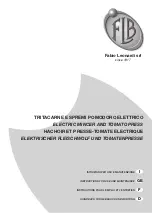
Downloaded from www.vandenborre.be
• You must have the correct isolation devices: line pro-
tecting cut-outs, fuses (screw type fuses removed from
the holder), earth leakage trips and contactors.
• When you connect electrical appliances to mains sock-
ets, do not let cables touch or come near the hot appli-
ance door.
• Do not use multi-way plugs, connectors and extension
cables. There is a risk of fire.
• Make sure not to squash or cause damage to the mains
plug (if applicable) and cable behind the appliance.
• Make sure that the mains connection is accessible after
the installation.
• Do not pull the mains cable to disconnect the appli-
ance. Always pull the mains plug (if applicable).
• Do not replace or change the mains cable. Contact the
service centre.
Gas connection
• Only an approved gas installer can install and connect
the appliance. Contact an approved service centre. This
is to prevent the risks of structural damage or physical
injury.
• Make sure that airflow around the appliance is good. A
defective air supply can cause lack of oxygen.
• Before installation, make sure that the local distribution
conditions (gas type and pressure) and the adjustment
of the appliance are compatible.
• Information about the gas supply is on the rating plate.
• This appliance is not connected to a combustion prod-
ucts evacuation device. It must be installed and con-
nected in accordance with current installation regula-
tions. Particular attention must be given to the relevant
requirements regarding ventilation.
• The use of a gas cooking appliance cause heat and
moisture in the room in which it is installed. Make sure
that ventilation in the kitchen is good: keep natural
ventilation holes open or install a mechanical ventila-
tion device (mechanical extractor hood).
• More ventilation (for example opening of a window or
increasing the level of mechanical ventilation where
present) is necessary when you operate the appliance
intensively for a long time .
Use
• Only use the appliance for domestic cooking tasks. Do
not use the appliance for commercial and industrial
use. This is to prevent physical injury to persons or
• Always monitor the appliance during operation.
• Always stay away from the appliance when you open
the door while the appliance is in operation. Hot steam
can release. There is a risk of burns.
• Do not use this appliance if it is in contact with water.
Do not operate the appliance with wet hands.
• Do not use the appliance as a work surface or storage
• The cooking surface of the appliance becomes hot dur-
ing use. There is a risk of burns. Do not put metallic
objects, for example cutlery or saucepans lids, on the
surface, as they can become hot.
• The interior of the appliance becomes hot during use.
There is a risk of burns. Use gloves when you insert or
remove the accessories or pots.
• The appliance and its accessible parts become hot dur-
ing use. Take care to avoid touching the heating ele-
ments. Young children must be kept away unless con-
tinuously supervised.
• Open the door carefully. The use of ingredients with al-
cohol can cause a mixture of alcohol and air. There is
the risk of fire.
• Do not let sparks or open flames come near the appli-
ance when you open the door.
• Do not put flammable products or items that are wet
with flammable products, and/or fusible objects (made
of plastic or aluminium) in, near or on the appliance.
There is a risk of explosion or fire.
• Set the cooking zones to "off" after each use.
• Do not use the cooking zones with empty cookware or
without cookware
• Do not let cookware boil dry. This can cause damage to
the cookware and hob surface.
• If an object or cookware falls on the hob surface, the
surface can be damaged.
• Do not put hot cookware near to the control panel be-
cause the heat can cause a damage to the appliance.
• Be careful when you remove or install the accessories
to prevent damage to the appliance enamel.
• Cookware made of cast iron, cast aluminium or with
damaged bottoms can scratch the hob surface if you
move them on the surface.
21
















































